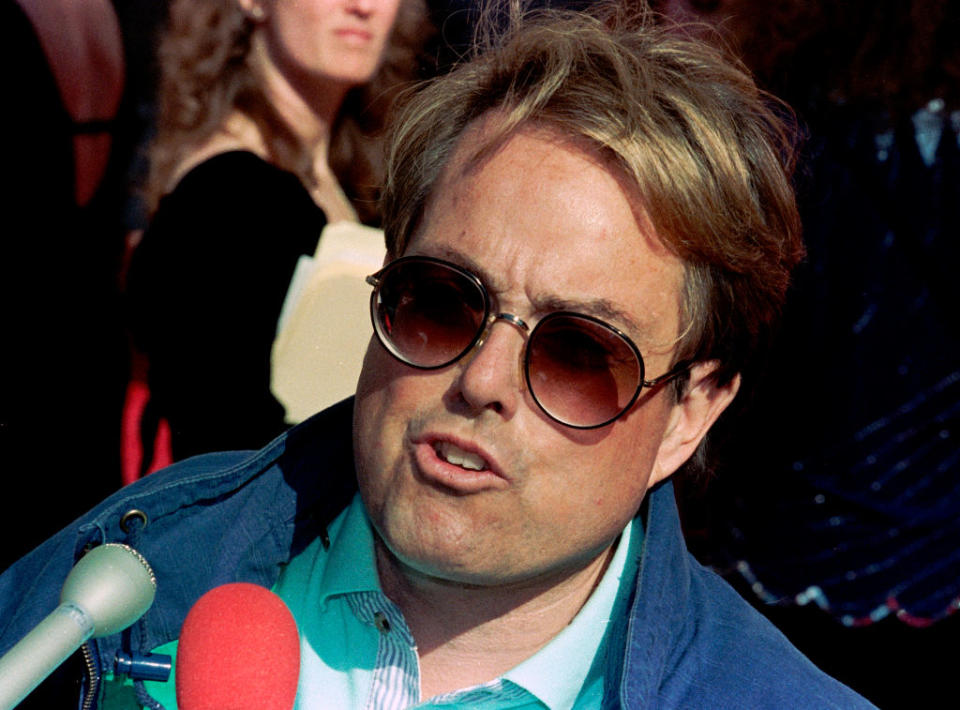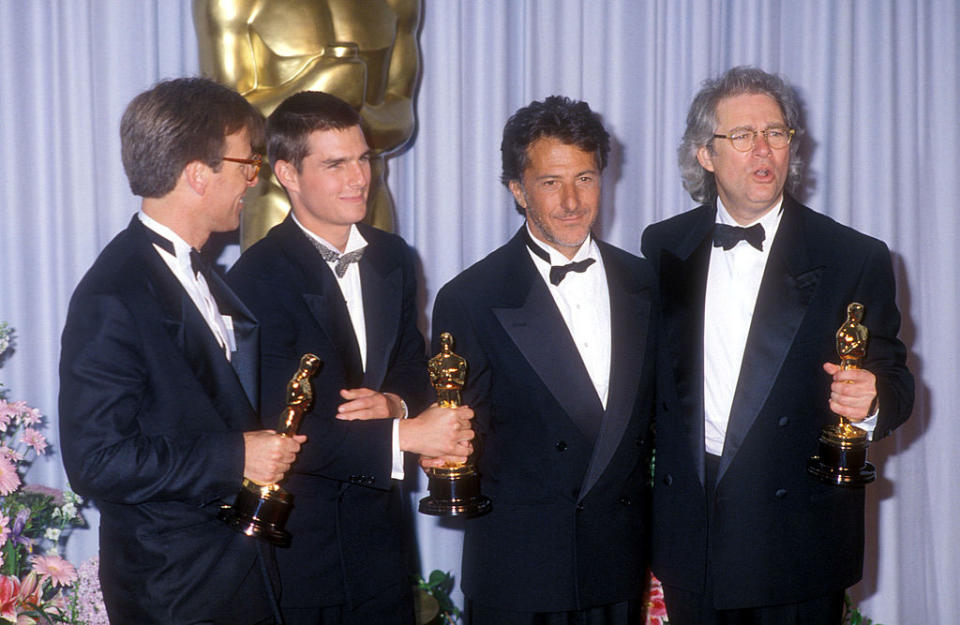The 61st Oscars’ Disastrous ‘Snow White’ Opening Sketch Is What WTF Looked Like in 1989

- Oops!Something went wrong.Please try again later.
Jeff Margolis will never forget his first time directing the Academy Awards — we won’t let him.
This year marks the 35th anniversary of the 61st Academy Awards. You may not remember that “Rain Man” won Best Picture, Barry Levinson Best Director, Dustin Hoffman Best Actor, and Jodie Foster Best Actress for “The Accused.” But seared into our collective subconscious is the production number that opened the show — already, you’re cringing at the thought — featuring Snow White and Rob Lowe.
More from IndieWire
To this day, clickbait headlines (from The Guardian in 2019: “How Snow White and Some Coconuts Killed the 1989 Oscars”) are a testament to that debacle’s enduring legacy. Hollywood, nor the world, had never seen anything like it, which was kind of the whole point of the thing, according to Margolis, who spoke to IndieWire about his memories of what Collider just last year proclaimed, “the worst moment in Oscars history…a duet from the depths of hell.”
Margolis, whose memoir “We’re Live in 5″ is out now, is one of Hollywood’s most prolific variety directors, with more than 50 years of estimable credits, including “Richard Pryor: Live in Concert” and the TV specials “Julie & Carol: Together Again” and “Sinatra 75: The Best is Yet to Come,” plus a host of award shows and music videos. “Directing the Oscars was a childhood dream,” he said.
From the day his father bought a television set when he was five, he was enthralled by variety shows. And the Oscars, he said, were the pinnacle.
The previous year’s 1988 ceremony, while a ratings winner, received prevailing negative reviews. Tom Shales in The Washington Post called it “unusually lackluster from the word go.” Something radical was required. Enter Allan Carr, producer of the blockbuster screen adaptation of “Grease” and the Tony Award-winning musical, “La Cage Aux Folles.” The often caftan-clad showman eagerly accepted the Academy’s and ABC’s mandate to do something different. “And if anyone could do something different, it was Allan Carr,” Margolis said.

By this time, Margolis was doing a lot of work for ABC. “My good friend, John Hamlin, who passed away last January, was vice president of ABC Entertainment,” Margolis said. “He knew my dream was to do the Oscars. He called me and said, ‘I have a question: How would you like to direct the Oscars?’ He told me Allan Carr was the producer. He co-managed Ann-Margret and we had worked together on a couple of specials for her. When Allan heard they were thinking of me to direct, he said in that way of his, ‘Perr…fect.’”
A week before the Oscars, Carr made an announcement at the traditional nominee’s luncheon: “I promise, it’s not going to be boring.”
“And he was right,” Margolis said with a laugh.
The two had a good working relationship, according to MARGOLIS. “Allan liked to work from his big, beautiful home in the Hollywood Hills. He never came to the production office. We’d sit in front of the fireplace and talk about the show,” he said. “One night, Allan said, ‘I have this great idea for the opening production number, and he told me the idea. He said the number would run about 20-25 minutes. I said, ‘Pardon me? This isn’t Broadway, this is not a motion picture. This is television. You cannot do a 25-minute opening number at the Oscars. It’s a disaster waiting to happen. People will be changing the channel after five minutes.”
Carr’s response? “You’ll make it sing.”
The idea was inspired by “Beach Blanket Babylon,” a satirical musical revue in San Francisco that ran for 45 years. In that show, Snow White traveled the world looking for her Prince Charming. For the Oscars, Snow White would come to Hollywood. But as the number took shape, Margolis had his hands full trying to rein in Carr’s campiest impulses. “He listened to most of the things I said,” Margolis said, “But a lot of times, he said, ‘The Academy asked me to make it different, so I’m going to make it different.’ I said, ‘OK, Allan, but you’re going to get shit for this.’”
Margolis and company had five days in the Shrine Auditorium for rehearsal. He had recently directed the American Music Awards there, but this was the Oscars, after all, his childhood dream come true, and when he first entered, Margolis said, “I had to pinch myself. All those sketches I saw when I worked with the art director and production designer were now full-life sets. It was the most exciting feeling.”
The excitement carried through the staging of the opening number, in which Snow White (Eileen Bowman) arrives in Hollywood, hobnobs on the red carpet, and enters the Shrine, greeting increasingly mortified A-listers in their seats. She enters a recreation of the famed Coconut Grove nightclub, where talk show host Merv Griffin croons his 1950 hit song, “I’ve Got a Lovely Bunch of Coconuts,” and a bevy of stars from Hollywood’s Golden Age (Vincent Price, Dorothy Lamour, Alice Faye, among them) are paraded out. Snow’s blind date, Lowe, joins her onstage, and they sing “Proud Mary” with specialty movie-themed lyrics.
This is what WTF looked like in 1989. And that’s how the show started.
Directing from the remote production truck in the Shrine parking lot, Margolis was in the moment and jazzed by everyone in the cast’s total commitment to the number as well as the creative challenge of putting all the number’s various parts together. None of the aged Hollywood stars, for example, were involved in the rehearsal and didn’t take their places onstage until Oscar night. “We thought, ‘Nobody’s ever done anything like this at the Oscars. This is going to be great.” Watching from the wings, Carr thought so, too.
Veteran Oscar writer Bruce Vilanch offered a sage post-mortem of the number. Margolis said, “Usually, the opening of the Oscars sets the tone for the evening, and the critics in the pressroom writing their reviews said this is going to be the worst Oscars.”
The show did get better. One of Carr’s ideas was to forego a host and instead pair presenters, including couples (Melanie Griffith and Don Johnson), costars (James Stewart and Kim Novak), and compadres (Sammy Davis, Jr. and Gregory Hines). Another change instituted was substituting “And the winner is….” with “And the Oscar goes to….”, which became permanent.
Mileage varied on another song and dance number, introduced by Bob Hope and Lucille Ball (who died weeks later) featuring “the Stars of Tomorrow” (Corey Feldman, Blair Underwood, Patrick Dempsey, Rikki Lake, and Mayim Bialik, among them). Margolis recruited Kenny Ortega (later of “Newsies,” “Hocus Pocus,” and “Dirty Dancing” fame), with whom he had collaborated on an Olivia Newton-John special, to choreograph it. “He saved that number,” Margolis said.
There were ominous signs that Snow White had been ill-received. “At the Governor’s Ball [following the Oscars], Allan said to me that he was hearing from a lot of people that the opening number was too long and too much,” Margolis said. “I said to him that there were going to be as many people who liked it.”
Indeed, Carr received flowers and kudos from the likes of Jennifer Jones (“You delivered”), Janet Leigh (“How did you manage to convince everyone not to acknowledge the manicurists?”), and agent Michael Ovitz (“You put the show business back to the movie business”). A Los Angeles Times article reported that Michael Caine had toasted Carr at a party at Chasen’s.

The ratings were spectacular. Forty-two million viewers tuned in in the United States, making it the most-viewed ceremony up to that point. Margolis, in part, credits the Snow White number. “People were curious,” he said with a laugh. “Once they saw the opening number, they thought, ‘What’s this show going to be like?’ and they stuck around.”
It did not take long for the shit that Margolis predicted to hit the fan. The reviews were dreadful. That opening number, New York Times film critic Janet Maslin wrote, “deserves a permanent place in the annals of Oscar embarrassments.” Disney was up in arms over the unauthorized use of Snow White. Seventeen Hollywood dignitaries from A (Julie Andrews) to Z (director Fred Zinnemann), put their distinguished names on a statement that read: “The 61st Academy Awards show was an embarrassment to both the Academy and the entire motion picture industry. It is neither fitting nor acceptable that the best work in motion pictures be acknowledged in such a demeaning fashion. We urge the president and governors of the Academy to ensure that future award presentations reflect the same standard of excellence as that set by the films and filmmakers they honor.”
In that Los Angeles Times article, a stung, but defiant Carr was quoted, “What have we done? We’ve touched the heart of America and won the town.” He would never produce again. He died in 1999.
The Snow White number has not undergone a critical reassessment, a la, say, “Ishtar” or “Heaven’s Gate,” but just last week, Tony Bravo, writing in San Francisco Chronicle’s weekly arts and entertainment guide, wrote a tribute of sorts. “America was not ready,” he writes. “I still think what really didn’t register with its critics was that it was so quintessentially San Francisco — which is what I love about it.”
Margolis emerged relatively unscathed, and he remains proud of the 1989 show, with its 12 scene changes and innovations. The reviewers reserved their venom for Carr. The director was not mentioned. Later that year, Margolis rebounded with the Emmy-winning, “Sammy Davis, Jr.’s 60th Anniversary Special.” He would go on to direct seven consecutive Oscar broadcasts, for which he was honored with two Directors Guild Awards and one Emmy.
Six months after the Oscars, he said, he ran into Rob Lowe. “He looked at me and winked, and I winked. And that was about it. I made it through the storm.”
The next year, Billy Crystal hosted the ceremony for the first time. He greeted the applauding audience with, “Is that for me, or are you just glad I’m not Snow White?”
Best of IndieWire
The 65 Best Sci-Fi Movies of the 21st Century, from 'Melancholia' and 'M3GAN' to 'Asteroid City'
Christopher Nolan Movies, Ranked from 'The Dark Knight' and 'Tenet' to 'Dunkirk' and 'Oppenheimer'
Where to Watch This Week's New Movies, Including 'Argylle' and 'How to Have Sex'
Sign up for Indiewire's Newsletter. For the latest news, follow us on Facebook, Twitter, and Instagram.

